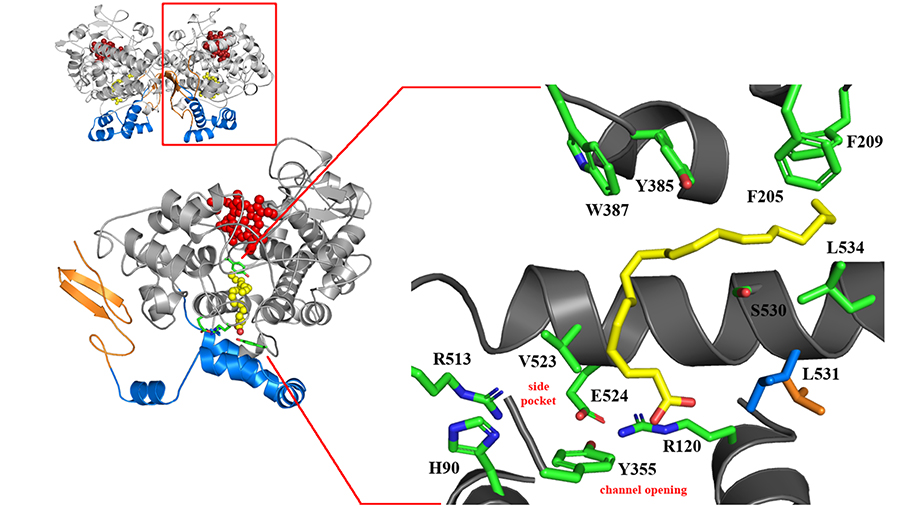A new hotspot for cyclooxygenase inhibition
Prostaglandins, or PGs, are critical players in such physiological housekeeping functions as the regulation of renal water and sodium metabolism, blood clotting, parturition, and stomach acid secretion. These potent lipid signaling molecules are derived from the oxygenation of arachidonic acid by prostaglandin endoperoxide H synthases 1 and 2, commonly called cyclooxygenase-1 and -2, or COX-1 and COX-2.
Abnormal changes in PG production contribute to disease pathologies including inflammation and cancer, so researchers view COX-1 and COX-2 as pharmacological targets. Indeed, nonselective nonsteroidal anti-inflammatory drugs, or NSAIDs, such as ibuprofen, inhibit both isoforms, while coxibs such as Celebrex selectively inhibit COX-2.

COX enzymes are sequence homodimers; each subunit consists of physically distinct cyclooxygenase and peroxidase active sites linked by a bridging heme moiety. In solution, the enzymes function as heterodimers, such that only one subunit is catalytically active at a time.
Structurally, COX-1 and COX-2 are virtually identical. However, subtle differences drive isoform-specific substrate specificity and inhibition. Among these are the substitutions of cyclooxygenase channel residues Ile-434, His-513 and Ile-523 in COX-1 for Val-434, Arg-513 and Val-523 in COX-2, which result in the formation of a unique side pocket and increased volume of the cyclooxygenase active site in COX-2. This side pocket, with Arg-513 at its base, has been exploited in the design of coxibs aimed at reducing the gastrointestinal side effects caused by conventional NSAIDs.
Many researchers focus on time-dependent inhibition of COX-2, working to identify the conformational changes that drive the transitions between the kinetically observable inhibitor binding states. These studies originally focused on the COX-2 side pocket, but recent molecular dynamics simulations identified a different region of the active site critical for aspirin and Celebrex to inhibit COX-2. These simulations identified rotation of the side chain of the residue Leu-531, opposite the side pocket, as a way to expand further the volume of the cyclooxygenase channel. Indeed, crystal structures of COX-2 have provided evidence for the existence of alternate rotamer conformations for this side chain when different ligands are bound.
To evaluate the importance of the conformational flexibility of the side chain of Leu-531, our research group generated L531F and L531N mutations and showed that these substitutions reduced aspirin and Celebrex’s inhibition of COX-2. Thus, expansion of the active site volume via the flexibility associated with the side chain of Leu-531 allows Celebrex to achieve a high-affinity binding state and facilitates formation of the initial noncovalent complex in the case of aspirin acetylation.
Deciphering the protein conformational motions associated with COX catalysis and inhibition is the next major frontier in studying this enzyme. If we understand how the binding of substrates, allosteric activators and inhibitors induce conformational motions to modulate COX activity, we will be closer to developing and repurposing drugs for maximum efficacy with minimal risks.
Enjoy reading ASBMB Today?
Become a member to receive the print edition four times a year and the digital edition monthly.
Learn moreGet the latest from ASBMB Today
Enter your email address, and we’ll send you a weekly email with recent articles, interviews and more.
Latest in Science
Science highlights or most popular articles

The science of staying strong
Muscles power every movement, but they also tell the story of aging itself. Scientists are uncovering how strength fades, why some species resist it and what lifestyle and molecular clues could help preserve muscle health for life.

Bacteriophage protein could make queso fresco safer
Researchers characterized the structure and function of PlyP100, a bacteriophage protein that shows promise as a food-safe antimicrobial for preventing Listeria monocytogenes growth in fresh cheeses.

Building the blueprint to block HIV
Wesley Sundquist will present his work on the HIV capsid and revolutionary drug, Lenacapavir, at the ASBMB Annual Meeting, March 7–10, in Maryland.

Gut microbes hijack cancer pathway in high-fat diets
Researchers at the Feinstein Institutes for Medical Research found that a high-fat diet increases ammonia-producing bacteria in the gut microbiome of mice, which in turn disrupts TGF-β signaling and promotes colorectal cancer.

Mapping fentanyl’s cellular footprint
Using a new imaging method, researchers at State University of New York at Buffalo traced fentanyl’s effects inside brain immune cells, revealing how the drug alters lipid droplets, pointing to new paths for addiction diagnostics.

Designing life’s building blocks with AI
Tanja Kortemme, a professor at the University of California, San Francisco, will discuss her research using computational biology to engineer proteins at the 2026 ASBMB Annual Meeting.

